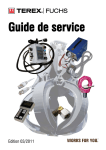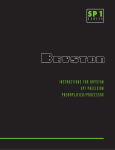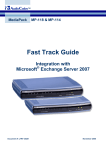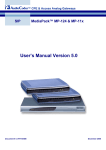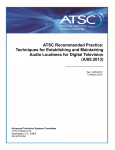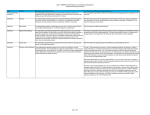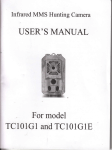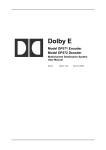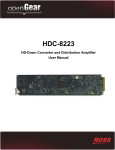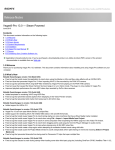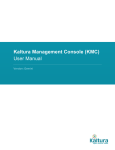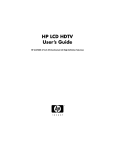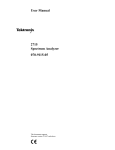Download Conversion of ATSC Signals for Distribution to NTSC Viewers
Transcript
ATSC Recommended Practice: Conversion of ATSC Signals for Distribution to NTSC Viewers Document A/79, 12 December 2008 Advanced Television Systems Committee, Inc. 1750 K Street, N.W., Suite 1200 Washington, D.C. 20006 Advanced Television Systems Committee Document A/79 The Advanced Television Systems Committee, Inc., is an international, non-profit organization developing voluntary standards for digital television. The ATSC member organizations represent the broadcast, broadcast equipment, motion picture, consumer electronics, computer, cable, satellite, and semiconductor industries. Specifically, ATSC is working to coordinate television standards among different communications media focusing on digital television, interactive systems, and broadband multimedia communications. ATSC is also developing digital television implementation strategies and presenting educational seminars on the ATSC standards. ATSC was formed in 1982 by the member organizations of the Joint Committee on InterSociety Coordination (JCIC): the Electronic Industries Association (EIA), the Institute of Electrical and Electronic Engineers (IEEE), the National Association of Broadcasters (NAB), the National Cable Telecommunications Association (NCTA), and the Society of Motion Picture and Television Engineers (SMPTE). Currently, there are approximately 140 members representing the broadcast, broadcast equipment, motion picture, consumer electronics, computer, cable, satellite, and semiconductor industries. ATSC Digital TV Standards include digital high definition television (HDTV), standard definition television (SDTV), data broadcasting, multichannel surround-sound audio, and satellite direct-to-home broadcasting. Contact information is given below. Mailing address Telephone Web site E-mail Advanced Television Systems Commmittee, Inc. 1750 K Street, N.W., Suite 1200 Washington, D.C. 20006 202-872-9160 (voice) 202-872-9161 (fax) http://www.atsc.org [email protected] Note: The user's attention is called to the possibility that compliance with this recommended practice may require use of an invention covered by patent rights. By publication of this document, no position is taken with respect to the validity of this claim or of any patent rights in connection therewith. One or more patent holders may have filed a statement regarding the terms on which such patent holder(s) may be willing to grant a license under these rights to individuals or entities desiring to obtain such a license. The ATSC Patent Policy and Patent Statements are available at http://www.atsc.org. The revision history of this document is given below. A/79 Revision History A/79 approved 12 December 2008 2 Conversion of ATSC Signals for Distribution to NTSC Viewers, Table of Contents 12 December 2008 Table of Contents 1. SCOPE 7 1.1 Introduction and Background 7 2. REFERENCES 8 3. DEFINITIONS 10 3.1 Compliance Notation 3.2 Treatment of Syntactic Elements 3.3 Symbols, Abbreviations, and Mathematical Operators 3.4 Acronyms and Abbreviations 3.5 Terms 10 10 10 10 12 4. SYSTEM FUNCTIONALITY 12 5. ATSC RECEPTION AND PROCESSING FOR CONVERSION TO ANALOG (NTSC) 14 5.1 Reception and Decode 5.2 Video Processing 5.2.1 Conversion of Compressed Formats 5.2.1.1 Horizontal Dimension 5.2.1.2 Vertical Dimension 5.2.2 Aspect Ratio control 5.2.3 Color Space Conversions from HD to SD 5.3 Audio Processing 5.3.1 Main Program Audio 5.3.2 Secondary Audio Program (SAP) 5.3.3 Use of Audio Metadata for Determining Main and SAP Placement 5.3.4 Considerations for Continued Use of Existing Equipment 5.4 Data Signals Processing 5.4.1 CEA-608 Data 5.4.2 ANSI/SCTE 127 Data 6. ATSC RECEPTION AND PROCESSING FOR CONVERSION TO SD DIGITAL 14 14 15 15 15 15 16 17 17 17 17 18 18 18 18 18 6.1 Reception and Decode 18 6.2 Video Processing 19 6.2.1 Conversion of Compressed Formats 19 6.2.2 Aspect Ratio Control 19 6.2.3 Color Space Conversions from HD to SD 19 6.3 Audio Processing 19 6.3.1 Main Program Audio 19 6.3.2 Second Program Audio 19 6.3.3 Use of Audio Metadata for Determining Main and Second Audio Placement 19 6.3.4 Considerations for Continued Use of Existing Equipment 20 6.4 Data Signals Processing 20 6.4.1 CEA-608 Data 20 6.4.2 ANSI/SCTE 127 Data 20 7. BROADCAST STATION INFRASTRUCTURE GUIDELINES 7.1 AFD Infrastructure 20 20 3 Advanced Television Systems Committee Document A/79 7.1.1 AFD Generation 7.1.2 Image Processing Considerations 7.1.3 VANC Data Considerations 7.1.4 AFD Insertion in the ATSC Encoder 7.2 ATSC Encoding Video Alignment 7.3 Closed Captioning and CEA-608 Data Infrastructure 7.3.1 CEA-608 Data 7.3.2 Content Advisory 7.4 ANSI/SCTE 127 Data 7.5 Audio Processing 7.5.1 Audio Metadata 7.6 PSIP Considerations 20 21 21 21 22 22 22 23 23 23 23 24 Annex A: Active Format Description 25 A1. INTRODUCTION 25 4 Conversion of ATSC Signals for Distribution to NTSC Viewers, Table of Contents 12 December 2008 Index of Tables and Figures Table A.1 AFD Format Conversion Illustrations 26 Figure 4.1 Conceptual block diagram: ATSC bitstream conversion to analog NTSC video, audio, and data. Figure 4.2 Conceptual block diagram: ATSC bitstream conversion to digital SD SDI video with audio and data. Figure 4.3 Correct color matrix conversion; luminance portion of the color bar signal. Figure 4.4 Incorrect color matrix conversion; luminance portion of the color bar signal. 5 13 14 16 16 ATSC Recommended Practice: Conversion of ATSC Signals for Distribution to NTSC Viewers 1. SCOPE This Recommended Practice (RP) provides guidance to broadcasters and other creators of ATSC high-definition (HD) or standard-definition (SD) content and to the operators of Multichannel Video Programming Distributor (MVPD) systems (such as cable or direct to home satellite). It recommends the equipment capabilities needed to provide the highest quality programming to viewers who only receive NTSC services. In case of any uncertainty about whether ATSC Transport Streams conform to the relevant standards or to the recommendations in this document, then local coordination should occur to resolve any ambiguous or omitted signaling. This RP covers professional equipment and excludes any recommendations for design or implementation of consumer equipment. Delivery to the home is not addressed by this Recommendation. 1.1 Introduction and Background In preparation for the 2009 digital transition, broadcasters, cable systems, and satellite providers will need to arrange for distribution of broadcast channels to their standard definition viewers. Many markets will not have direct access to NTSC or serial digital interface (SDI) SD versions of broadcast services, but will be limited to direct reception of ATSC digital television (DTV) signals. These DTV signals may contain HD or SD formats. This recommendation provides guidance for the creation of the replacement NTSC signal. Two cases are explicitly covered and one case is implicitly covered. The first case is direct delivery via NTSC on a RF channel. The second case is for head-end facilities that have SDI interconnections from the broadcast station signal receive rack to the multi-channel system transmit rack holding NTSC modulators or other suitable transmission equipment, which may require different techniques than those used for direct conversion to NTSC. These guidelines cover equipment capabilities needed to support both scenarios. The implicit case is for multi-channel systems that do not have the ability to deliver an analog signal (except at the output of the consumer’s STB), such as IPTV or DBS. In the implicit case, the distribution system is treated as a “black box” with this recommendation only addressing how to replicate the NTSC or baseband digital input to the IPTV or DBS head-end. This document provides basic technical recommendations and guidelines for equipment capabilities supporting distribution of HD originated broadcasts, SD 16:9, and all other ATSC standard coding formats, with provision for either direct down-conversion to analog, or an intermediary down-conversion to SDI, which then is converted to analog for rendering on consumers’ NTSC sets. When generating an NTSC or SDI signal, with associated audio and data, from the ATSC transmitted format, the following capabilities should be considered: 1) Format conversion under control of AFD Page 7 Advanced Television Systems Committee Document A/79 2) Extraction of CEA-608 data 3) Preservation and distribution of content advisories 4) Preservation and distribution of ANSI/SCTE 127 data 5) Identification and proper AC-3 5.1 down-mix to Lt/Rt for main audio 6) Identification and proper AC-3 5.1 down-mix for second audio program (SAP) 7) Proper choice of AC-3 Dynamic Range Compression (DRC) profile This recommendation does not include processing of ATSC signals for delivery to SCTE 54 or SCTE 128 compliant receivers. It is noted that the SCTE Standards for delivery of digital transport streams using QAM signals, and the associated reception/decode for display via many combinations of equipment are well documented by the cable industry. 2. REFERENCES At the time of publication, the editions indicated below were valid. All documents are subject to revision, and parties to agreement based on this RP are encouraged to investigate the possibility of applying the most recent editions of the documents listed below. [1] ATSC: “ATSC Digital Television Standard, Part 1 – Digital Television System,” Doc. A/53 Part 1:2007, Advanced Television Systems Committee, Washington, D.C., 3 January 2007. [2] ATSC: “Recommended Practice – Transport Stream Verification,” Doc. A/78A, Advanced Television Systems Committee, Washington, D.C., 9 May 2007. [3] SMPTE: SMPTE 292 (2006), “1.5 Gb/s Signal/Data Serial Interface,” Society of Motion Picture and Television Engineers, White Plains, N.Y. [4] SMPTE: SMPTE 259M (2006), “SDTV Digital Signal/Data – Serial Digital Interface,” Society of Motion Picture and Television Engineers, White Plains, N.Y. [5] SMPTE: SMPTE 170M (2004), “Composite Analog Video Signal – NTSC for Studio Applications,” Society of Motion Picture and Television Engineers, White Plains, N.Y. [6] ATSC: “ATSC Digital Television Standard, Part 4 – MPEG-2 Video System Characteristics with Amendment No. 1,” Doc. A/53 Part 4:2007, Advanced Television Systems Committee, Washington, D.C., 24 December 2007 (Amendment No. 1 dated 24 December 2007). [7] SMPTE: SMPTE 125M (1995), “Component Video Signal 4:2:2 – Bit-Parallel Digital Interface,” Society of Motion Picture and Television Engineers, White Plains, N.Y. [8] SMPTE: RP202 (2008), “Video Alignment for Compression Coding,” Society of Motion Picture and Television Engineers, White Plains, N.Y. [9] CEA: CEB16, “Active Format Description (AFD) and Bar Data Recommended Practice,” Consumer Electronics Association, Arlington, VA, 31 July 2006. [10] ITU: ITU-R BT.709-5 (2002), “Parameter Values for the HDTV Standards for Production and International Programme Exchange”. [11] ITU: ITU-R BT.601-5 (1995), “Studio Encoding Parameters of Digital Television for Standard 4:3 and Wide-Screen 16:9 Aspect Ratios”. 8 Conversion of ATSC Signals for Distribution to NTSC Viewers 12 December 2008 [12] FCC: OET Bulletin No. 60, Revision A (1986), “Multichannel Television Sound Transmission and Audio Processing Requirements for the BTSC System.” [13] ATSC: “Digital Audio Compression Standard (AC-3, E-AC-3),” Doc. A/52B, Advanced Television Systems Committee, Washington, D.C., 14 June 2005. [14] CEA: CEA-608-D, “Line 21 Data Services,” Consumer Electronics Association, Arlington, VA, May 2007. [15] SCTE: ANSI/SCTE 127-2007, “Carriage of Vertical Blanking Interval (VBI) Data in North American Digital Television Bitstreams,” Society of Cable Telecommunications Engineers, Exton, PA. [16] CEA: CEA-708-D, “Digital Television (DTV) Closed Captioning,” Consumer Electronics Association, Arlington, VA, August 2008. [17] ATSC: “Carriage of Legacy TV Data Services,” Doc. A/99, Advanced Television Systems Committee, Washington, D.C., 23 July 2008. [18] SMPTE: SMPTE 334-1-2007, “Vertical Ancillary Data Mapping of Caption Data and Other Related Data,” Society of Motion Picture and Television Engineers, White Plains, N.Y. [19] SMPTE: SMPTE 2031 (2007), “Carriage of DVB/SCTE VBI Data in VANC,” Society of Motion Picture and Television Engineers, White Plains, N.Y. [20] SMPTE: SMPTE 2016-1 (2007), “Format for Active Format Description and Bar Data,” Society of Motion Picture and Television Engineers, White Plains, N.Y. [21] SMPTE: SMPTE 2016-3 (2007), “Vertical Ancillary Data Mapping of Active Format Description and Bar Data,” Society of Motion Picture and Television Engineers, White Plains, N.Y. [22] SMPTE: SMPTE 333-2008, “DTV Closed-Caption Server to Encoder Interface,” Society of Motion Picture and Television Engineers, White Plains, N.Y. [23] SMPTE: EG43-2004, “System Implementation of CEA-708-B and CEA-608-B Closed Captioning,” Society of Motion Picture and Television Engineers, White Plains, N.Y. [24] SMPTE: SMPTE 334-2 (2007), “Caption Distribution Packet (CDP) Definition,” Society of Motion Picture and Television Engineers, White Plains, N.Y. [25] ATSC: “Program and System Information Protocol for Terrestrial Broadcast and Cable (Revision C) With Amendment No. 1,” Doc. A/65C, Advanced Television Systems Committee, Washington, D.C., 9 May 2006. [26] ATSC: “ATSC Digital Television Standard, Part 3 – Service Multiplex and Transport Subsystem Characteristics,” Doc. A/53 Part 3:2007, Advanced Television Systems Committee, Washington, D.C., 3 January 2007. [27] CEA: CEA-2020:2006, “Other VBI Waveforms,” Consumer Electronics Association, Arlington, VA, August 2006. [28] DVB/ETSI: ETSI TS 101 154 V1.8.1, Digital Video Broadcasting (DVB): “Implementation Guidelines for the use of MPEG-2 Systems, Video and Audio in Satellite, Cable and Terrestrial Broadcasting Applications,” Annex B, June 2007. 9 Advanced Television Systems Committee Document A/79 [29] SCTE: ANSI/SCTE 54-2004, “Digital Video Service Multiplex and Transport System Standard for Cable Television,” Society of Cable Telecommunications Engineers, Exton, PA. [30] SCTE: ANSI/SCTE 128 2007, “AVC Video Systems and Transport Constraints for Cable Television,” Society of Cable Telecommunications Engineers, Exton, PA. 3. DEFINITIONS 3.1 Compliance Notation This RP contains no normative references or mandatory requirements. 3.2 Treatment of Syntactic Elements This document contains symbolic references to syntactic elements used in the audio, video, and transport coding subsystems. These references are typographically distinguished by the use of a different font (e.g., restricted), may contain the underscore character (e.g., sequence_end_code) and may consist of character strings that are not English words (e.g., dynrng). 3.3 Symbols, Abbreviations, and Mathematical Operators The symbols, abbreviations, and mathematical operators used herein are as found in Section 3.4 of ATSC A/53 Part 1 [1] and as herein specified. Numbers preceded by 0x are to be interpreted as hexadecimal values and numbers within single quotes (e.g., ‘10010100’) are to be interpreted as a string of binary digits. 3.4 Acronyms and Abbreviations The following acronyms and abbreviations are used within this specification. AC-3 – ATSC Digital Audio Compression Standard (see A/52 [13]) AFD – Active Format Description AMOL – Automated Measurement of Lineups ANSI – American National Standards Institute ASI – Asynchronous Serial Interface ATSC – Advanced Television Systems Committee BTSC – Broadcast Television Systems Committee CEA – Consumer Electronics Association CDP – Caption Distribution Packet CM – Component Missing (see A/78 [2]) compr – DRC variable dBFS – deciBels Full Scale DBS – Direct Broadcast Satellite DRC – Dynamic Range Compression DTV – Digital Television 10 Conversion of ATSC Signals for Distribution to NTSC Viewers 12 December 2008 DVB – Digital Video Broadcasting dynrng – DRC variable EIT – Event Information Table ETSI – European Telecommunications Standards Institute FCC – Federal Communications Commission FM – Frequency Modulation IPTV – Internet Protocol (IP) Television IRD – Integrated Receiver/Decoder (sometimes termed Receiver/Descrambler, but not in these systems. ATSC content is always in the “clear”) ITU – International Telecommunication Union HANC – Horizontal ANCillary HD – High-Definition HDTV – High-Definition Television HD-SDI – High-Definition Serial Digital Interface (compliant with SMPTE 292 [3]) MPEG – Moving Picture Experts Group MVPD – Multichannel Video Programming Distributor NTSC – National Television System Committee PCM – Pulse Code Modulation PID – Packet IDentifier PIRD – Professional Integrated Receiver/Decoder (see IRD above) POA – Program Off Air (see A/78 [2]) PSIP – Program and System Information Protocol QAM – Quadrature Amplitude Modulation QOS – Quality of Service (see A/78 [2]) RF – Radio Frequency RP – Recommended Practice SAP – Secondary Audio Program SCTE – Society of Cable Telecommunications Engineers SD – Standard Definition SDI – Serial Digital Interface (compliant with SMPTE 259M [4]) SDTV – Standard Definition Television SMPTE – Society of Motion Picture and Television Engineers STB – Set-Top Box 11 Advanced Television Systems Committee Document A/79 TNC – Technically Non-Conformant (see A/78 [2]) TOA – Transport-stream Off-Air (see A/78 [2]) TS – Transport Stream VANC – Vertical ANCillary VBI – Vertical Blanking Interval VSB – Vestigial Sideband XDS – eXtended Data Services 3.5 Terms The following terms are used within this specification. ATSC Professional Integrated Receiver/Decoder (PIRD) – A device employed in a broadcast station, MVPD headend or similar professional location, which has the capability to produce NTSC or SDI video, with associated audio and data, from all ATSC standard formats. Bar data – Additional information which accompanies AFD data providing exact sizes of either top and bottom bars or side bars for image aspect ratios other than 4:3 or 16:9 such as widescreen movies. Line – A specification of a given television scanning line number, defined in different image format standards. For NTSC, the line numbers are as defined by Figure 7 of SMPTE 170M [5]1. VANC – An acronym for Vertical ANCillary (data space). In a broadcast facility, in uncompressed SDI/HD-SDI, the Vertical ANCillary (VANC) data space is used for VBI and other non-video signals. VBI – An acronym for Vertical Blanking Interval, which is composed of the first 20 horizontal lines in each NTSC field (see definition of Line, above). These lines are not intended to be directly displayed by a receiver. In digital systems, the VBI does not exist, although the line numbers are allocated as if it does. Frequently, lines 21 and 22 are considered a part of VBI, but such classification is technically incorrect. 4. SYSTEM FUNCTIONALITY There are several different system architectures that may be deployed by MVPDs. 1) Systems which pass through the ATSC Transport Stream with minor modifications (such as changing the Terrestrial Virtual Channel Table in the PSIP for a Cable Virtual Channel Table). This document will not discuss this system architecture further. 2) Systems which convert the ATSC Transport Stream into an analog NTSC signal and modulate that for delivery to their customers. Such a system is outlined in Figure 4.1 and discussed in Section 5. 1. Note that SMPTE 170M [5] does not use “Field x, Line y” nomenclature, rather lines are numbered from the start of Fields 1 and 3. See ANSI/SCTE 127 § 7.1.4 for a conversion formula. 12 Conversion of ATSC Signals for Distribution to NTSC Viewers ATSC transport stream MPEG-2 TS DEMUX Video PES Video PES 708 caption extractor 12 December 2008 608 compatibility bytes extraction 608 Data Video decoder 525 line video Video PES AFD extractor SCTE 127 data extractor Video format conversion AFD formatting information Data insertion 525 line video with data NTSC composite video NTSC Encoder AMOL and other data Main audio program select Main audio program decoder Audio downmix to stereo/LtRt Second audio program select Second audio program decoder Audio downmix to mono Stereo/LtRt program audio To BTSC encoder and RF modulator Mono SAP audio NOTE: Care must be taken to ensure the proper synchronization of video, audio, and associated data at the output of this system Figure 4.1 Conceptual block diagram: ATSC bitstream conversion to analog NTSC video, audio, and data. 3) Systems which convert the ATSC Transport Stream into a digital 4:3 SD signal and then send that digitized signal to the MVPD transmit rack. Such a system is outlined in Figure 4.2 and discussed in Section 6. Note that in this case the transmit rack may hold NTSC modulators or suitable transmission equipment for digital systems such as IPTV or DBS. The possible further compression stage during distribution should be kept in mind during the discussion in Section 6. Some MVPDs currently convert the legacy NTSC input signal to digital form (or accept a predigitized signal) and use a digital infrastructure to deliver the digital signal to NTSC generators2 at points remote from the input. The other directly provided digital signals that may use this same infrastructure are private by nature and are out of scope of this RP. This RP does not address delivery of digital signals to residences and is silent on the requirements that exist for MVPD owned and/or consumer owned devices in residences which include providing NTSC signals with certain characteristics. While legal and regulatory advice for such devices is out of scope of this document, the reader’s attention is drawn to the FCC Rules dealing with digital conversion of ATSC signals by consumer devices with NTSC outputs if the delivery system does not provide NTSC signals directly to consumer devices. Figures 4.1 and 4.2 are conceptual block diagrams showing the steps that must be taken to properly recover the video, audio, and data signals but not necessarily in the precise order required 2. These generators may be found in home STBs or other locations. Such NTSC generation processes are out of scope of this RP. 13 Advanced Television Systems Committee ATSC transport stream MPEG-2 TS DEMUX Video PES Video PES Document A/79 608 compatibility bytes extraction 708 caption extractor Video decoder 608 Data Digital video Digital 525 line video with VANC or VBI data 525 line video Video PES AFD extractor SCTE 127 data extractor Video format conversion AFD formatting information VANC/VBI data formatter Main audio program select SMPTE 337 HANC data formatter Second audio program select SMPTE 337 HANC data formatter VANC/ VBI insertion HANC insertion SD SDI To MVPD transport rack AMOL and other data Main program audio Second audio NOTE: Care must be taken to ensure the proper synchronization of video, audio, and associated data at the output of this system Figure 4.2 Conceptual block diagram: ATSC bitstream conversion to digital SD SDI video with audio and data. to build an implementation. It is out of scope for this document to supply implementation specifics. MVPD system operators should understand these block diagrams as outlining functionality which should be included in equipment they deploy; again, with the understanding that different devices may process steps differently. 5. ATSC RECEPTION AND PROCESSING FOR CONVERSION TO ANALOG (NTSC) ATSC PIRDs with analog NTSC outputs should have the following capabilities. 5.1 Reception and Decode ATSC PIRDs should support reception and decoding of 8-VSB ATSC signals that conform to ATSC Digital Television Standard A/53 [1]. The conceptual block diagram (Figure 4.1) does not include RF or other electrical interfaces, rather assumes an MPEG-2 Transport Stream (TS) as a starting point. MPEG-2 TS monitoring and alarm generation should follow the ATSC A/78 [2] recommendations. Default alarming should be restricted to TOA, POA, and CM, with selection of QOS at operator discretion. TNC errors should be ignored. 5.2 Video Processing When an NTSC analog video signal with associated audio and data is not directly available from a broadcast station, the MVPD may derive this signal from the available ATSC signal. To ensure proper formatting and delivery of the converted signal, ATSC PIRDs should have the following capabilities. 14 Conversion of ATSC Signals for Distribution to NTSC Viewers 5.2.1 12 December 2008 Conversion of Compressed Formats ATSC PIRDs should support format conversion of any A/53 Part 4 [6] Table 6.2 video format, as well as the 720x480 video format, to NTSC analog format in accordance with SMPTE 170M [5]. 5.2.1.1 Horizontal Dimension 1080-line and 720-line HD video formats should be downconverted to fill an active line with 720 pixels as defined in SMPTE 125M [7]. 480-line SD video may be coded as lines of 720, 704, or 640 pixels. If coded as 720 pixels, the reconstructed video will map directly into an active line as defined in SMPTE 125M [7]. If the coded video lines are 704 pixels long, the reconstructed video should be centered on the line as defined in SMPTE 125M [7], with the first eight and last eight pixels of the full 720-pixel active line set at black. Video coded as 640x480 should be scaled horizontally to fill the full active line as defined in SMPTE 125M [7]. SMPTE 125M [7] defines the relationship between the 525-line digital pixel samples and the equivalent analog video signal required for the output of the conversion process. 5.2.1.2 Vertical Dimension In analog NTSC services, the first line of the picture is line 23; the preceding lines (even those defined as “active video” in the FCC Rules) typically contain data services (including captions) or test signals. It is therefore recommended that PIRDs with downconversion capabilities should convert all incoming HD or SD signals to 480 lines, which should include any bars inserted as part of the aspect ratio conversion (see Section 5.2.2). The first line of converted video (including such bars, if present) should be placed on line 23 of the analog video output. This arrangement allows for new line 21 data to be added to the NTSC output signal (see Section 5.4.1). It should be noted that for letterbox output video, the first line of the active image will typically start at line 53. Although ATSC A/53 Part 4 [6] Table 6.2 SD formats all specify a vertical size value of 480 lines, SMPTE 170M [5] and SMPTE 125M [7] (both of which predate the widespread use of video compression) stipulate 486 lines for the image size. Some existing baseband downconverter units may produce image sizes with more than 480 lines, typically in the range 484 to 487 lines. This variation from the recommendation for 480 lines should be recognized if such format converters are used in a MVPD facility. Implementers should consult SMPTE RP202 [8] for additional guidance on format conversions. 5.2.2 Aspect Ratio control In conversion to a 4:3 SD raster, ATSC PIRDs should support aspect ratio control with the following configurable options for 16:9 source conversion to the 4:3 aspect ratio: • “Center-Cut” – forced aspect ratio conversion to center-cut, ignoring AFD • “Letterbox” – forced aspect ratio conversion to letterbox, ignoring AFD • “Auto” – automatic selection of center-cut or letterbox as activated by the ATSC AFD data decoded from input. (See Annex A for details). When in Auto, ATSC PIRDs should support control of picture aspect ratio through AFD with the following additional capabilities • Switch between aspect ratio modes should be frame accurate following AFD data. 15 Advanced Television Systems Committee Document A/79 • When valid AFD data is no longer present, ATSC PIRDs should be able to automatically switch to a user programmable setting (center-cut or letterbox). This is intentionally different from the consumer equipment advice given in CEA-CEB16 [9]. If the incoming signal has a 4:3 coded frame, under all circumstances the full frame should be used and the output signal should be 4:3. Any AFD present should be ignored. 5.2.3 Color Space Conversions from HD to SD When the HDTV signal is downconverted the ITU-R BT.709 [10] color space should be converted to NTSC (SMPTE 170M [5] / SMPTE 125M [7] / BT.601 [11]) color space. Figure 4.3 shows a correct downconversion, while Figure 4.4 shows a color matrix error. Figure 4.3 Correct color matrix conversion; luminance portion of the color bar signal. Figure 4.4 Incorrect color matrix conversion; luminance portion of the color bar signal. 16 Conversion of ATSC Signals for Distribution to NTSC Viewers 12 December 2008 5.3 Audio Processing The conversion of the ATSC sound program should be done in a manner that will present the NTSC listener with main and secondary program services whose loudness (with respect to 100 percent aural modulation) and dynamic range are as close to the existing NTSC services as possible. The conversion process should consider the fact that NTSC receivers may not be able to reproduce as wide a dynamic range audio signal as some ATSC receivers or home theater systems. It should also take into account that the gain structure of existing NTSC receivers is optimized for program dialog levels in the order of 17 to 20 dB below peak FM modulation. 5.3.1 Main Program Audio The main program audio decoder should be set to produce a stereo-compatible Dolby Surround downmix (also called Pro Logic®, Left-total/Right-total, or Lt/Rt downmix) of the multichannel source program that is suitable for Dolby Surround Pro Logic® decoding (this downmix mode will not affect an incoming stereo program signal). It should also be set to RF Mode3, and have compression and dialog normalization enabled at all times. The gain structure of the converter should allow a 0 dBFS signal level in the digital domain of the Main Audio Program decoder to produce 100 percent modulation of the NTSC aural carrier. 5.3.2 Secondary Audio Program (SAP) The Secondary Audio Program (SAP) decoder should be set to produce a monaural4 downmix. It should also be set to the RF mode, and have compression and dialog normalization enabled at all times. The analog signal levels produced by the Secondary Audio Program decoder (or associated DACs) should be set so that 0 dBFS SAP signal produces 100 percent modulation in the BTSC [12] domain. Implementers should also ensure that the bandwidth of the SAP channel does not exceed the 10 kHz mandated by the BTSC standard. (This function may be performed by the BTSC modulator itself.) 5.3.3 Use of Audio Metadata for Determining Main and SAP Placement When there is only one audio stream, it should be mapped to NTSC main audio. Mapping of multiple ATSC audio streams to the NTSC main and SAP audio channels should be based on the priority field of the AC-3 descriptor defined in A/52 [13], Section A.3.4. When there is more than one audio stream: • If one stream’s priority field is set to the value ‘01’ (Primary Audio) that stream should be placed on the main BTSC audio channel. • If one stream’s priority field is set to the value ‘10’ (Other Audio) that stream should be placed on the SAP channel. 3. In RF Mode, the overall program level is raised 11 dB (which brings the program loudness closer to NTSC practice) while the peaks are limited to prevent signal overload in the D/A converter. Also see ATSC Digital Audio Compression Standard (AC-3, E-AC-3) A/52 [13] Sections 7.7.2 and 7.7.2.1 for details of the compr gain word used in the RF Mode. 4. In some cases, the monaural sum is implemented downstream from the 2-channel output of the audio decoder IC. However, some decoder IC manufacturers may directly support a monophonic downmix. 17 Advanced Television Systems Committee Document A/79 When three or more audio streams are present in the ATSC Virtual Channel, all audio streams that have the priority field set to ‘11’ (Not specified) should be assumed to be neither the main nor SAP audio. 5.3.4 Considerations for Continued Use of Existing Equipment Some existing ATSC PIRDs select and route audio services by PID value. The broadcaster should attempt to maintain consistent PID assignments for the audio service intended for NTSC Main and the audio service intended for NTSC SAP. 5.4 Data Signals Processing This section addresses the processing of CEA-608 [14] and ANSI/SCTE 127 [15] data. 5.4.1 CEA-608 Data ATSC PIRDs should conform to the guidelines of CEA-708 [16], Sections 9.23, 9.24, 9.25, 10.1, and Annex B regarding the processing of CEA-608 [14] datastream bytes. All CEA-608 [14] datastream bytes are expected to be present, including all 4 caption services, all 4 text services and all XDS packets. Special attention should be paid to decoder handling of the XDS content advisory packet (type=5) according to CEA-708 [16]. When present, CEA-608 [14] data carried per A/53 Part 4 [6] should take precedence over any line 21 (or line 284) data present in ANSI/ SCTE 127 [15] payloads. Where CEA-608 [14] data is recovered and reinserted into analog line 21 format, it is important that CEA-608 [14] null pairs (0x80, 0x80) are not inserted between redundant transmissions of CEA-608 [14] control pairs. It has been found that CEA-608 [14] decoders compliant with FCC specifications will display anomalies if this null code insertion occurs between redundant transmissions of certain command pairs and all special and extended character pairs. 5.4.2 ANSI/SCTE 127 Data ATSC PIRDs should decode ANSI/SCTE 127 [15] payloads carried per ATSC A/99 [17] and should re-encode all the payload data as analog waveforms on the appropriate line. When present, CEA-608 [14] data carried per A/53 Part 4 [6] should take precedence over any line 21 (or line 284) data present in ANSI/SCTE 127 [14] payloads. 6. ATSC RECEPTION AND PROCESSING FOR CONVERSION TO SD DIGITAL ATSC PIRDs with baseband digital outputs should have the following capabilities. 6.1 Reception and Decode ATSC PIRDs should support reception and decoding of 8-VSB ATSC signals that conform to ATSC Digital Television Standard A/53 [1]. The conceptual block diagram (Figure 4.2) does not include RF or other electrical interfaces, rather assumes an MPEG-2 Transport Stream (TS) as a starting point. MPEG-2 TS monitoring and alarm generation should follow the ATSC A/78 [2] recommendations. Default alarming should be restricted to TOA, POA, and CM, with selection of QOS at operator discretion. TNC errors should be ignored. 18 Conversion of ATSC Signals for Distribution to NTSC Viewers 12 December 2008 6.2 Video Processing When a 4:3 SD digital SDI video signal with associated audio and data is not directly available from a broadcast station, the MVPD may derive this signal from the available ATSC signal. To ensure proper formatting and delivery of the converted signals, ATSC PIRDs should have the following capabilities. 6.2.1 Conversion of Compressed Formats The considerations detailed in Section 5.2.1 apply except that the output video format should be SDI (SMPTE 259M [4] compliant). 6.2.2 Aspect Ratio Control The considerations detailed in Section 5.2.2 apply except that the output video format is SDI. 6.2.3 Color Space Conversions from HD to SD The considerations detailed in Section 5.2.3 apply except that the output video format is SDI. 6.3 Audio Processing The ATSC PIRD should produce PCM or a passed-through AC-3 stream. Depending on the system architecture, the digital audio signals from the ATSC PIRD may be either embedded in the video SDI signal (as shown in Figure 4.2) or provided as separate non-embedded outputs. In all cases, care must be taken to preserve audio/video synchronization. Audio may be embedded with its associated video or routed directly. 6.3.1 Main Program Audio If the downstream equipment being fed directly by the PIRD supports PCM, then the ATSC Professional PIRD should output left and right channel PCM for the SDI transport. If the downstream equipment supports AC-3 inputs, then that should be output. The advantage of using AC-3 is the associated AC-3 metadata can then reach other equipment downstream. In any case the audio processing recommendations of Section 5.3 should be followed. 6.3.2 Second Program Audio If the downstream equipment being fed directly by the PIRD supports PCM, then the ATSC Professional PIRD should output monaural PCM for the SDI transport. If the downstream equipment supports AC-3 inputs, then that is also an option. The advantage of using AC-3 is the associated AC-3 metadata can then reach other equipment downstream. In any case the audio processing recommendations of Section 5.3 should be followed. 6.3.3 Use of Audio Metadata for Determining Main and Second Audio Placement When there is only one audio stream, it should be mapped to main audio. Mapping of multiple ATSC audio streams to the main and second audio channels should be based on the priority field of the AC-3 descriptor defined in A/52 [13], Section A.3.4. When there is more than one audio stream: • If one stream’s priority field is set to the value ‘01’ (Primary Audio) that stream should be placed on the main audio channel. 19 Advanced Television Systems Committee Document A/79 • If one stream’s priority field is set to the value ‘10’ (Other Audio) that stream should be placed on the second audio channel. When three or more audio streams are present in the ATSC Virtual Channel, all audio streams that have the priority field set to ‘11’ (Not specified) should be assumed to be neither the main nor second audio. 6.3.4 Considerations for Continued Use of Existing Equipment Some existing ATSC PIRDs select and route audio services by PID value. The broadcaster should attempt to maintain consistent PID assignments for the audio service intended for SD digital main and the audio service intended for SD digital secondary audio. 6.4 Data Signals Processing Processing of data signals is of necessity different from their handling in an NTSC conversion. The metadata associated with the incoming ATSC TS that is needed to control the eventual creation of an NTSC signal (including data) as described in see Section 5 should be mapped into a suitable carriage method for delivery to the transmit rack. 6.4.1 CEA-608 Data To provide a data service consistent with current practices for distribution of broadcasters’ analog signals, CEA-608 [14] data, as detailed in Section 5.4.1, should be delivered to the digital system for eventual insertion into line 21 of the NTSC output signal in other equipment downstream. CEA-608 [14] data may be inserted in SDI as VANC data per SMPTE 334-1 [18] or as VBI data consisting of digital samples of the analog waveform. CEA-608 [14] data should be conveyed in a format that is compatible with downstream equipment being fed directly by the PIRD. 6.4.2 ANSI/SCTE 127 Data The ATSC PIRD should decode ANSI/SCTE 127 [15] payloads carried per ATSC A/99 [17] and should either insert all the payload data as VANC packets per SMPTE 2031 [19] or as VBI data consisting of digital samples of the analog waveform. ANSI/SCTE 127 [15] data should be conveyed in a format that is compatible with downstream equipment being fed directly by the PIRD. Care should be taken to ensure proper timing in relationship to the associated video is maintained. When present, CEA-608 [14] data carried per SMPTE 334-1 [18] or as VBI data should take precedence over any line 21 (or line 284) data present in ANSI/SCTE 127 [15] payloads. 7. BROADCAST STATION INFRASTRUCTURE GUIDELINES 7.1 AFD Infrastructure In order for the automatic aspect ratio control function described in Section 5 to work correctly, it is necessary for the ATSC video signal from the broadcaster to include associated AFD data as described in Annex A. Points to note are described below. 7.1.1 AFD Generation How and where AFD is generated will depend on the operational practices of the broadcaster but in most cases the data defined in SMPTE 2016-1 [20] is expected to be inserted into the VANC in 20 Conversion of ATSC Signals for Distribution to NTSC Viewers 12 December 2008 baseband SDI or HD-SDI signals as described in SMPTE 2016-3 [21]. AFD insertion may occur in various places, such as during production or postproduction of programs and advertisements, at network facilities, at the syndicator, and at local broadcast stations. Specifics are out of scope of this RP. In all cases, the AFD should correctly describe the image characteristics of the associated video signal. Full AFD information always includes the aspect ratio of the coded frame, as well as the four-bit AFD code. During insertion of commercial advertisements, care should be taken to ensure the correct AFD information describing the advertisement’s image characteristics is signaled. AFD codes may also be set as part of the ATSC encoding process under automation control, see Section 7.1.4. SMPTE 2016-1 [20] and ATSC A/53 Part 4 [6] also define bar data that may be associated with AFD. The use of bar data is not covered in this RP. 7.1.2 Image Processing Considerations Various video processes that signals pass through during the broadcast production and distribution chain may change the aspect ratio of the active image area and/or coded frame. These include: up and down format converters, aspect ratio converters, video switchers, and digital video effects units. Whenever such video processing and conversion occurs, the equipment should process the associated incoming AFD such that the AFD data on the output correctly describe the associated output video signal, as described in SMPTE 2016-1 [20], Section 7. It should be noted that while AFD signaling helps to eliminate the “postage stamp” affect that can occur when receivers show bars all around a small active image, broadcasters still need to ensure that signals coded for transmission do not lead to this effect. In particular, AFD cannot signal the presence of “letterbox” and “pillarbox” bars simultaneously, so such picture formats should never be broadcast. 7.1.3 VANC Data Considerations Many devices in the studio processing chain (e.g., production switchers, digital effects units, recorders, and video servers) may pass data on only a small subset of lines in the VANC space and some devices may not pass VANC packets at all. Care should therefore be taken in selecting the location of AFD data packets to be carried in VANC and in designing video systems to ensure that the integrity of the VANC data path is maintained. Guidance on this is provided in Annex B of SMPTE 2016-3 [21]. Contribution and network distribution systems often carry video in compressed form where VANC data is not included. In this case, other arrangements should be made to enable the data to be distributed to the destination along with the video. 7.1.4 AFD Insertion in the ATSC Encoder Irrespective of where it is originally generated, for over-the-air transmission the AFD data is inserted into video user data by the ATSC station encoder. Many current generation encoders are capable of extracting the AFD data placed in VANC and inserting it into the MPEG-2 video user data. Some encoders are also capable of setting AFD codes based on user presets or external commands. 21 Advanced Television Systems Committee Document A/79 Station output bitstreams using AFD should at all times contain valid AFD data consistent with the associated video. The intermittent presence of AFD is highly undesirable as it may result in unknown operation of equipment downstream. 7.2 ATSC Encoding Video Alignment It is recommended that the spatial alignment of pixels and lines set out in SMPTE RP202 [8] should be used for the ATSC encoding of video signals for broadcast. This will help ensure that signal decoding and conversion occurring downstream will result in output signals with optimum video images. This is especially important for SD signals where the vertical placement of the coded 480 lines can vary if not correctly specified. It is also noted that the inclusion of line 21 and line 22 in broadcast DTV programming may result in very visible and undesirable visual artifacts at the top of the picture on many DTV receiver displays and this should be avoided. 7.3 Closed Captioning and CEA-608 Data Infrastructure ATSC transmissions must conform to the requirements of A/53 Part 4 [6] regarding the carriage of CEA-708 [16] closed caption data. Such caption data may be supplied to the ATSC encoder via mechanisms defined in SMPTE 334-1 [18] or SMPTE 333 [22] (and possibly others). Guidance on the implementation of systems for DTV closed captioning is provided in SMPTE EG43 [23]. Typically such systems use caption distribution packets (CDPs), now defined in SMPTE 334-2 [24], which include CEA-708 [16] caption data, CEA-608 [14] data, and caption service information. As occurred with NTSC program distribution, insertion of closed captioning data may occur at the network release facility and some captioning may occur at the local broadcast station. Current generation CEA 708 [16] caption equipment allows for CDPs distributed with a video signal from a network to be modified if necessary downstream at the local station so that captions may be added or modified for the program being transmitted. 7.3.1 CEA-608 Data In accordance with the requirements of A/53 Part 4 [6] as well as the guidelines of CEA-708 [16], the closed captioning data carried in the ATSC bitstream from the broadcaster should include CEA-608 [14] data as well as CEA-708 [16] captioning data. It is important to note that the CEA-608 [14] data should include all the data that would normally have carried in the broadcaster’s previous NTSC service, including all 4 caption services, all 4 text services and all XDS bytes. Where the CEA-608 [14] data is generated and inserted into the CDPs depends on the operational practices of the broadcaster. If an NTSC signal chain including CEA-608 [14] line 21 data is maintained within the broadcast facility, then the CEA-608 [14] data may be simply bridged to the CEA-708 [16] caption generator device that inserts the CDPs into the SDI or HDSDI video signal. Where the line 21 infrastructure is no longer present, then alternative paths should be established to provide this data to the CEA-708 [16] caption generator. As occurred with NTSC program distribution, some CEA-608 [14] data may originate at the network release facility and some or all at the local broadcast station. Current generation CEA708 [16] caption equipment allows for CDPs distributed with a video signal from a network to be modified if necessary downstream at the local station so they include valid and current CEA-608 22 Conversion of ATSC Signals for Distribution to NTSC Viewers 12 December 2008 [14] data for the program being transmitted, including content advisory (V-Chip), network name, time-of-day, and other “air time specific” XDS packets. 7.3.2 Content Advisory Broadcasters should ensure consistency between the XDS content advisory bytes (“V-chip”) carried in CEA-608 [14] data and the content advisory information carried in PSIP [25] for the same program. Depending on the operational practices of the broadcaster, it may be desirable to provide equipment that reads EIT data from the PSIP for the broadcast and verifies or inserts appropriate data into incorrect or missing XDS bytes. 7.4 ANSI/SCTE 127 Data The ATSC encoder should encode ANSI/SCTE 127 [15] payloads if provisioned to do so. CEA608 [14] data should be carried per A/53 Part 4 [6] as mentioned in Section 7.2.1, rather than ANSI/SCTE 127 [15]. 7.5 Audio Processing To facilitate the downstream conversion of the ATSC sound program, the local broadcast station should ensure that the AC-3 encoder audio service, bit stream information parameters, preprocessing conditions etc.5 6, are set appropriately for each audio stream of program material being encoded. If pre-compressed AC-3 audio is being passed-through at the station, then station personnel should take care to ensure the settings in the stream are correct. The station should also set the dialnorm parameter value appropriately for each audio stream of program material being encoded. The appropriate value may either be fixed, in which case the dialog level of the program should be adjusted (before transmission) to match the fixed dialnorm value, or the dialnorm parameter should be set to match the actual dialog level of each program being transmitted. The station should also set, in the absence of a Dynamic Range Compression (DRC) profile specified by the original program producer, the Line and RF mode DRC profiles to Film Standard, for each audio stream of program material being encoded. Note that if the dialnorm parameter value does not represent the dialog level of the program, the quality of the audio delivered to the NTSC service may be compromised. Specifically, a large mismatch between the dialnorm value and the actual dialog level can result in severe overcompression of the program, even if the encoder compression profile is set to “None”. This is done to avoid the possibility of even more annoying signal clipping in the decoder. 7.5.1 Audio Metadata Proper setting of audio metadata is important to the mapping of multiple ATSC audio streams to the NTSC main and SAP audio channels. Special attention is called to the priority field of the AC-3 descriptor defined in A/52 [13], Section A.3.4. For the main ATSC audio stream, the priority field 5. See audio encoder’s user manual for additional information. 6. Note that some older (than the DP569) Dolby Digital Multichannel Audio Encoders may allow “RF Overmodulation protection” to be enabled or disabled. Experience has shown that audio quality is improved when this is disabled and therefore it should be disabled. 23 Advanced Television Systems Committee Document A/79 should be set to the value ‘01’ (Primary Audio). For an ATSC audio stream intended to be mapped to the NTSC SAP audio, the priority field should be set to ‘10’ (Other Audio). When three or more audio streams are present in the ATSC Virtual Channel, for all audio streams that are neither the main nor SAP audio, the priority field should be set to ‘11’ (Not specified) for each. Although not needed for audio mapping, encoders should also ensure the language field is properly set according to A/53 Part 3 [26], and, when more than one audio service has the same language, the component_name_descriptor is required to be added according to A/65 [25]. 7.6 PSIP Considerations Station personnel need to understand that per ATSC A/65 [25] and the FCC Rules, they will continue to use their pre-transition major channel number, which in all cases was an NTSC broadcast channel assignment. This applies to those few stations which surrendered their analog channels pre-transition. Failure to use their analog channel number as their major channel number will result in confusing both their viewing audience (who are accustomed to thinking of channel ‘N’) and the relevant MVPDs (who are also accustomed to thinking of the station as channel ‘N’). 24 Annex A: Active Format Description 1. INTRODUCTION Active Format Description (AFD) is industry standard metadata that can be used to describe active picture information about a video signal. This metadata enables video processing devices to make automatic adjustments according to aspect ratio and other picture information signaled by the AFD, either for presentation on a video display or during conversion from one video format to another. The AFD code and bar data values are carried in the video user data of the MPEG-2 Elementary Stream in accordance with ATSC Digital Television Standard A/53 Part 4 [6]. AFD and bar data are also carried in the VANC space of baseband digital video signals in accordance with SMPTE 2016-3 [21]. The use of bar data is not covered in this RP. The AFD specifications provide for a variety of active format scenarios. The codes listed in Table A.1 are those that may legally be present in 16:9 digital video signals intended for transmission in the USA (excluding codes ‘0010’ and ‘0011’ which, although legal, are “not recommended” in the ATSC standard). Codes marked in Table A.1 as “Recommended” are those considered most likely to be in common use. The table illustrates various configurations for 16:9 frames that may be signaled with AFD and shows the format of the resulting 4:3 frames after down-conversion and/or aspect ratio conversion. With the exception of codes ‘1011’ and ‘1110’, all aspect ratio conversions shown are effectively a 4:3 “center cut” or a 16:9 “letterbox” operation. “Alternative center” as mentioned in some format descriptions refers to an area of essential picture information, in which case other parts of the picture may be cropped without significant loss to the viewer. The cross hatch areas in some converted frame illustrations show the extent of the letterbox bars that should be added by the video processing equipment. These bars are recommended to be black. AFD ‘0000’ indicates that image format information is not available and is undefined. Unless bar data is available, DTV receivers and video equipment should interpret the active image area as being the same as the coded frame. This code should be used with caution. For further information on AFD codes and the bar data that may be associated with AFD, see ATSC A/53 Part 4 [6] and SMPTE 2016-1 [20]. CEA-CEB16 [9] provides comprehensive Page 25 Advanced Television Systems Committee Document A/79 guidance on how consumer devices should respond to AFD and bar data; in some cases this is different from that shown here for professional equipment. Table A.1 AFD Format Conversion Illustrations AFD Code Aspect Ratio Description 0000 16:9 Undefined 0100 16:9 Letter box image with an aspect ratio greater than 16:9, vertically centered in the coded frame 1000 Recommended 16:9 Full frame 16:9 image, the same as the coded frame 1001 Recommended 16:9 Pillarbox 4:3 image, horizontally centered in the coded frame 1010 Recommended 16:9 Full frame 16:9 image, with no cropping permitted 1011 16:9 Pillarbox 14:9 image, horizontally centered in the coded frame 1101 16:9 Pillarbox 4:3 image, with 14:9 alternative center Original 16:9 Frame 26 Converted 4:3 Frame Conversion of ATSC Signals for Distribution to NTSC Viewers, Annex A Table A.1 AFD Format Conversion Illustrations 1110 16:9 Full frame 16:9 image, with 14:9 alternative center 1111 Recommended 16:9 Full frame 16:9 image, with 4:3 alternative center 27 12 December 2008 Advanced Television Systems Committee, Inc. 1750 K Street, N.W., Suite 1200 Washington, D.C. 20006




























